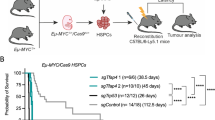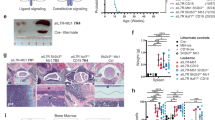Abstract
The requirement for receptor components and the signalling effector, signal transducer and activator of transcription (STAT) 5A/5B, was assessed genetically in a lymphoma development model induced by interleukin-7 (IL-7). This growth factor for T- and B-cell progenitors and mature lymphocytes activates survival and proliferative pathways including Bcl-2, phosphatidylinositol-3 kinase and STAT5. Overexpression of IL-7 in vivo causes early mortality from lymphoma development. Mice overexpressing IL-7 that were heterozygous for the IL-7Rα subunit showed improved survival compared to wild-type mice. In addition, STAT5A/5B+/− compound heterozygous mice with one targeted allele each of STAT5A and STAT5B showed striking amelioration of IL-7-induced mortality and disease development. STAT5A/5B+/− compound heterozygous mice were otherwise normal in stem cell and lymphocyte development and cellularity. Lower STAT5 protein levels accompanied the reduction in STAT5A/5B copy number, which suggests that STAT5 haploinsufficiency is a modifier of IL-7 signal strength.
This is a preview of subscription content, access via your institution
Access options
Subscribe to this journal
Receive 50 print issues and online access
$259.00 per year
only $5.18 per issue
Buy this article
- Purchase on Springer Link
- Instant access to full article PDF
Prices may be subject to local taxes which are calculated during checkout



Similar content being viewed by others
References
Benjamin D, Sharma V, Knobloch TJ, Armitage RJ, Dayton MA and Goodwin RG . (1994). J. Immunol., 152, 4749–4757.
Bradley HL, Hawley TS and Bunting KD . (2002). Blood, 100, 3983–3989.
Bunting KD, Bradley HL, Hawley TS, Moriggl R, Sorrentino BP and Ihle JN . (2002). Blood, 99, 479–487.
Cai Z, de Bruijn M, Ma X, Dortland B, Luteijn T, Downing RJ and Dzierzak E . (2000). Immunity, 13, 423–431.
Chazen GD, Pereira GM, LeGros G, Gillis S and Shevach EM . (1989). Proc. Natl. Acad. Sci. USA, 86, 5923–5927.
Cheng AM, Saxton TM, Sakai R, Kulkarni S, Mbamalu G, Vogel W, Tortorice CG, Cardiff RD, Cross JC, Muller WJ and Pawson T . (1998). Cell, 95, 793–803.
Dadi HK and Roifman CM . (1993). J. Clin. Invest., 92, 1559–1563.
Dalloul A, Laroche L, Bagot M, Mossalayi MD, Fourcade C, Thacker DJ, Hogge DE, Merle-Beral H, Debre P and Schmitt C . (1992). J. Clin. Invest., 90, 1054–1060.
Danilovich N and Sairam MR . (2002). Biol. Reprod., 67, 361–369.
Dibirdik I, Langlie MC, Ledbetter JA, Tuel-Ahlgren L, Obuz V, Waddick KG, Gajl-Peczalska K, Schieven GL and Uckun FM . (1991). Blood, 78, 564–570.
Fisher AG, Burdet C, LeMeur M, Haasner D, Gerber P and Ceredig R . (1993). Leukemia, 7 (Suppl 2), S66–S68.
Frishman J, Long B, Knospe W, Gregory S and Plate J . (1993). J. Exp. Med., 177, 955–964.
Grabstein KH, Waldschmidt TJ, Finkelman FD, Hess BW, Alpert AR, Boiani NE, Namen AE and Morrissey PJ . (1993). J. Exp. Med., 178, 257–264.
Hofmeister R, Khaled AR, Benbernou N, Rajnavolgyi E, Muegge K and Durum SK . (1999). Cytokine Growth Factor Rev., 10, 41–60.
Jegalian AG, Acurio A, Dranoff G and Wu H . (2002). Blood, 99, 2603–2605.
Kang J, DiBenedetto B, Narayan K, Zhao H, Der SD and Chambers CA . (2004). J. Immunol., 173, 2307–2314.
Kemkemer R, Schrank S, Vogel W, Gruler H and Kaufmann D . (2002). Proc. Natl. Acad. Sci. USA, 99, 13783–13788.
Kieslinger M, Woldman I, Moriggl R, Hofmann J, Marine JC, Ihle JN, Beug H and Decker T . (2000). Genes Dev., 14, 232–244.
Kondo M, Takeshita T, Higuchi M, Nakamura M, Sudo T, Nishikawa S and Sugamura K . (1994). Science, 263, 1453–1454.
Levy DE and Gilliland DG . (2000). Oncogene, 19, 2505–2510.
Lin JX and Leonard WJ . (2000). Oncogene, 19, 2566–2576.
Lin JX, Migone TS, Tsang M, Friedmann M, Weatherbee JA, Zhou L, Yamauchi A, Bloom ET, Mietz J, John S and Leonard WJ . (1995). Immunity, 2, 331–339.
Lord JD, McIntosh BC, Greenberg PD and Nelson BH . (2000). J. Immunol., 164, 2533–2541.
Moriggl R, Topham DJ, Teglund S, Sexl V, McKay C, Wang D, Hoffmeyer A, van Deursen J, Sangster MY, Bunting KD, Grosveld GC and Ihle JN . (1999). Immunity, 10, 249–259.
Nakae J, Biggs III WH, Kitamura T, Cavenee WK, Wright CV, Arden KC and Accili D . (2002). Nat. Genet., 32, 245–253.
Noguchi M, Yi H, Rosenblatt HM, Filipovich AH, Adelstein S, Modi WS, McBride OW and Leonard WJ . (1993). Cell, 73, 147–157.
Onishi M, Nosaka T, Misawa K, Mui AL, Gorman D, McMahon M, Miyajima A and Kitamura T . (1998). Mol. Cell. Biol., 18, 3871–3879.
Park SH, Liu X, Hennighausen L, Davey HW and Waxman DJ . (1999). J. Biol. Chem., 274, 7421–7430.
Puel A, Ziegler SF, Buckley RH and Leonard WJ . (1998). Nat. Genet., 20, 394–397.
Qin JZ, Kamarashev J, Zhang CL, Dummer R, Burg G and Dobbeling U . (2001a). J. Invest. Dermatol., 117, 583–589.
Qin JZ, Zhang CL, Kamarashev J, Dummer R, Burg G and Dobbeling U . (2001b). Blood, 98, 2778–2783.
Quon KC and Berns A . (2001). Genes Dev., 15, 2917–2921.
Ren S, Cai HR, Li M and Furth PA . (2002). Oncogene, 21, 4335–4339.
Rich BE, Campos TJ, Tepper RI, Moreadith RW and Leder P . (1993). J. Exp. Med., 177, 305–316.
Samaridis J, Casorati G, Traunecker A, Iglesias A, Gutierrez JC, Muller U and Palacios R . (1991). Eur. J. Immunol., 21, 453–460.
Saxton TM, Cheng AM, Ong SH, Lu Y, Sakai R, Cross JC and Pawson T . (2001). Curr. Biol., 11, 662–670.
Schluns KS, Kieper WC, Jameson SC and Lefrançois L . (2000). Nat. Immunol., 1, 426–432.
Seidman JG and Seidman C . (2002). J. Clin. Invest., 109, 451–455.
Sexl V, Piekorz R, Moriggl R, Rohrer J, Brown MP, Bunting KD, Rothammer K, Roussel MF and Ihle JN . (2000). Blood, 96, 2277–2283.
Shelburne CP, McCoy ME, Piekorz R, Sexl VV, Gillespie SR, Bailey DP, Gharse A, Mirmonsef P, Mann MN, Kashyap M, Wright HV, Chong HJ, Bouton LA, Ramirez CD, Lantz CS and Ryan JJ . (2002). Mol. Immunol., 38, 1187–1191.
Snow JW, Abraham N, Ma MC, Abbey NW, Herndier B and Goldsmith MA . (2002). Blood, 99, 95–101.
Socolovsky M, Fallon AE, Wang S, Brugnara C and Lodish HF . (1999). Cell, 98, 181–191.
Socolovsky M, Lodish HF and Daley GQ . (1998). Proc. Natl. Acad. Sci. USA, 95, 6573–6575.
Sudo T, Nishikawa S, Ohno N, Akiyama N, Tamakoshi M and Yoshida H . (1993). Proc. Natl. Acad. Sci. USA, 90, 9125–9129.
Teglund S, McKay C, Schuetz E, van DJ, Stravopodis D, Wang D, Brown M, Bodner S, Grosveld G and Ihle JN . (1998). Cell, 93, 841–850.
Trumper L, Jung W, Dahl G, Diehl V, Gause A and Pfreundschuh M . (1994). Ann. Oncol., 5 (Suppl 1), 93–96.
Udy GB, Towers RP, Snell RG, Wilkins RJ, Park S-H, Ram PA, Waxman DJ and Davey HW . (1997). Proc. Natl. Acad. Sci. USA, 94, 7239–7244.
Uehira M, Matsuda H, Hikita I, Sakata T, Fujiwara H and Nishimoto H . (1993). Int. Immunol., 5, 1619–1627.
van der Plas DC, Smiers F, Pouwels K, Hoefsloot LH, Löwenberg B and Touw IP . (1996). Leukemia, 10, 1317–1325.
Van Parijs L, Refaeli Y, Lord JD, Nelson BH, Abbas AK and Baltimore D . (1999). Immunity, 11, 281–288.
Venkitaraman AR and Cowling RJ . (1994). Eur. J. Immunol., 24, 2168–2174.
Williams IR, Rawson EA, Manning L, Karaoli T, Rich BE and Kupper TS . (1997). J. Immunol., 159, 3044–3056.
Zamorano J, Wang HY, Wang R, Shi Y, Longmore GD and Keegan AD . (1998). J. Immunol., 160, 3502–3512.
Acknowledgements
We thank Nancy Abbey for assistance with histology processing, John Carroll and staff for graphics help. Tg IL-7 mice and STAT5A/5B knockout mice were kindly provided by Dr Benjamin Rich and Dr James Ihle, respectively. NA was supported by a Damon Runyon Cancer Research Foundation Fellowship, DRG-1548. This work was supported by NIH RO1 Grant GM54351 (MAG), and the Canadian Institutes of Health Research (NA).
Author information
Authors and Affiliations
Corresponding author
Rights and permissions
About this article
Cite this article
Abraham, N., Ma, M., Snow, J. et al. Haploinsufficiency identifies STAT5 as a modifier of IL-7-induced lymphomas. Oncogene 24, 5252–5257 (2005). https://doi.org/10.1038/sj.onc.1208726
Published:
Issue Date:
DOI: https://doi.org/10.1038/sj.onc.1208726
Keywords
This article is cited by
-
Flip the coin: IL-7 and IL-7R in health and disease
Nature Immunology (2019)
-
A fully human anti-IL-7Rα antibody promotes antitumor activity against T-cell acute lymphoblastic leukemia
Leukemia (2019)
-
Interleukin‐7 in the transition of bone marrow progenitors to the thymus
Immunology & Cell Biology (2017)
-
MEK and PI3K-AKT inhibitors synergistically block activated IL7 receptor signaling in T-cell acute lymphoblastic leukemia
Leukemia (2016)
-
Interleukin 7 and thymic stromal lymphopoietin: from immunity to leukemia
Cellular and Molecular Life Sciences (2014)



